Podcasters Across Borders 2009 has wrapped up and the team of Mark Blevis and Bob Goyetche threw yet another impressive event. This year’s PAB theme was ostensibly bringing outside knowledge into the podcasting world, but the general subject of many of the presentations was on story more than anything – ways to more effectively communicate your story from Six String Nation to a Hollywood career. There were some spectacular new tools and techniques debuted which I look forward to integrating into my shows, the Financial Aid Podcast and Marketing Over Coffee, ideas that I think will, if they work well, bring things up a notch. Also picked up some great new photography techniques I’ll be trying out soon.
Along the way, I presented an 18 minute talk on monetization and why it’s vital to new media. Longtime readers of this blog will find many of the themes to be as familiar as old friends.
I also did my usual Sunday morning semi-improv presentation, My Top 20 Social Media Tools. Unlike the other presentation, I’m not publishing this presentation in any context, and here’s why: you had to be there and ready.
The Sunday morning presentation is always a tough one for people to make. It’s at 8 AM, which, after a night of partying, only the hardcore attendees can usually make. Delivering a super-tight, all-meat presentation that many have expressed a desire to see is my way of thanking them for making that extra effort to show up.
It’s also part of a martial arts lesson my teacher, Mark Davis of the Boston Martial Arts Center, is constantly reinforcing with us. Very often in the black belt class, he’ll show a technique only once as a way of helping us train our minds to capture and catch as much information as possible, to be vigilant about paying attention.
Social media in some ways makes us reliant on the crowd, reliant on the tools, reliant on waiting for someone to retweet or blog or podcast an important event. That laziness – and it is mental laziness – softens our ability to capture vitally important things that happen which may never happen again. Think about your own life. Have you ever had the experience of missing a child’s first important event, missing a news story break on the street right in front of you, missing a key piece of information at a conference? I know I’ve missed information, especially in the dojo, because of a lack of focus. I know I’ve missed some terrific photos due to inattentiveness.
Thus, that presentation will never happen again, at least not like that. The slides won’t be posted, the video won’t be uploaded, the information never shown again. If you were there – fully and wholly there, meaning you were paying attention and not twittering, blogging, chatting, etc. – then you got some information I hope you find useful. If you weren’t there, then please make the effort to actually show up at events like Podcasters Across Borders or PodCamp rather than hoping someone will live stream/live tweet/live be there for you. You’ll find that there are many more gems from the weekend which will probably not be published from other presenters and attendees as well.
Also, big shout outs to all of the longtime friends and fabulous conversations from the weekend, from Marko Kulik’s photo advice to intense debates about the future of media with Whitney Hoffman, Tod Maffin, and Julien Smith, to the many other great conversations over the weekend.
Did you enjoy this blog post? If so, please subscribe right now!
Get this and other great articles from the source at www.ChristopherSPenn.com








 We banter a lot in discussions about social media and the various applications of it. Twitter, for good or ill, has come to dominate a lot of people’s thinking about what social media is, despite it being only a small piece of the puzzle. That said, Twitter does a great job of encouraging brevity with a 140 character restriction per message. Sometimes this creates inscrutability or long streams of drivel broken into bite size chunks, but sometimes…
We banter a lot in discussions about social media and the various applications of it. Twitter, for good or ill, has come to dominate a lot of people’s thinking about what social media is, despite it being only a small piece of the puzzle. That said, Twitter does a great job of encouraging brevity with a 140 character restriction per message. Sometimes this creates inscrutability or long streams of drivel broken into bite size chunks, but sometimes…

